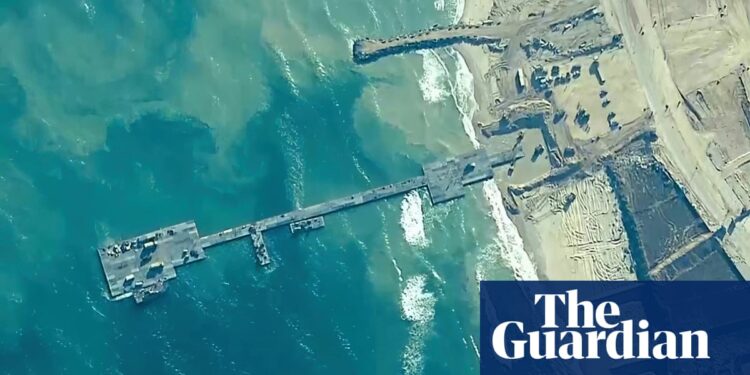Humanitarian assistance has begun to come ashore in Gaza from a US-made pier once more, two weeks after the short-lived sea corridor was suspended due to storm damage, but security concerns after one of the bloodiest days of the war meant the aid was not distributed.
The head of the World Food Programme (WFP), Cindy McCain, said the food distribution from the pier had been “paused” because she was “concerned about the safety of our people”. An Israeli military operation on Saturday freed four hostages but killed 274 Palestinians and left one Israeli commando dead. McCain said two of WFP’s warehouses in Gaza had also been rocketed and a staffer injured.
The suspension of WFP operations across Gaza is the latest in a string of obstacles that have dogged efforts to open a maritime aid corridor. The repaired pier had just been reattached to the Gaza coast on Friday after having been seriously damaged by a storm on 25 May. It had been operating for just five days before that.
After repairs in the Israeli port of Ashdod, it was floated back to the Gaza coast and on Saturday, 492 tonnes of food were unloaded from US naval vessels, the US Agency for International Development (USAid) said. That is roughly 30 truckloads, a 20th of what aid workers say is needed each day to contain the famine that has spread across Gaza.
USAid said it was working to restore distribution of the aid arriving at the pier.
“USAid remains in close contact with our colleagues from across the US government and humanitarian partners on the ground to ensure that aid can safely and effectively resume movement following completion of the security review that the humanitarian community is currently undertaking,” a USAID spokesperson said.
Since Joe Biden first announced on 7 March that the US military would build a pier and deliver aid by ship from Cyprus, humanitarian officials have expressed concern that the telegenic drama of the US operation, which costs $230m according to revised Pentagon estimates, would distract attention from the need for the international community to pressure Israel to open all land crossings – a far more efficient and cheaper means of delivering aid – and to improve distribution around Gaza.
The pier is only made to operate in conditions up to sea state 3, with waves up to 1.25 metres, and was intended as no more than a temporary complement to land crossings with a lifespan of three or four months before the sea becomes too choppy.
“Historically, by early September, the seas begin to rise and Mother Nature gets a vote here,” Vice-Admiral Brad Cooper, deputy head of US Central Command, said. “I think we’re just going to have to see what the weather looks like going forward.”
Meanwhile, the severity of the famine in northern Gaza has receded slightly, aid officials said, with a moderate increase in the number of trucks crossing through the West Erez crossing, on Gaza’s northern border near the coast and an Israeli base and kibbutz at Zikim. A total of 190 trucks crossed in the first five days in June. However, the situation there remained grave, according to aid agencies.
“Since 20 May, we have increased deliveries to the north of Gaza via the Zikim corridor resulting in modest improvements in the north,” a World Food Programme official said. “However, there are no fresh vegetables, and when available, the quality is very poor and prices are exorbitant.”
The most lethal conditions are now in southern Gaza, after more than a million people who had been sheltering in the southernmost city of Rafah were forced to flee by the Israeli offensive. The newly displaced population are now in makeshift camps, hard or impossible to reach from the southern crossing points at Rafah, on the Egyptian border, and Keren Shalom in southern Israel, which were the main access points for humanitarian deliveries until the Rafah offensive began a month ago.
Rafah crossing is now under Israeli military control and closed to traffic. Keren Shalom is functioning, with 764 trucks crossing so far in June, but only a fraction of those deliveries are reaching people in need because of the dangers of attempting aid distribution in such an active war zone.
“Conditions in the south are rapidly deteriorating,” a US official said. “The population displaced from Rafah are being displaced to places where there is absolutely no infrastructure. The humanitarian community has also lost a lot of access to warehouses and distribution points in and around Rafah because of the increased fighting and then the Rafah closure.
“More trucks are crossing, but it is now harder to distribute, particularly in the south, because the insecurity is so bad,” the official said.
Biden had threatened he would refuse to provide weapons for a Israeli offensive on Rafah in the absence of an adequate humanitarian plan, but US arms supplies to Israel have continued to flow.






